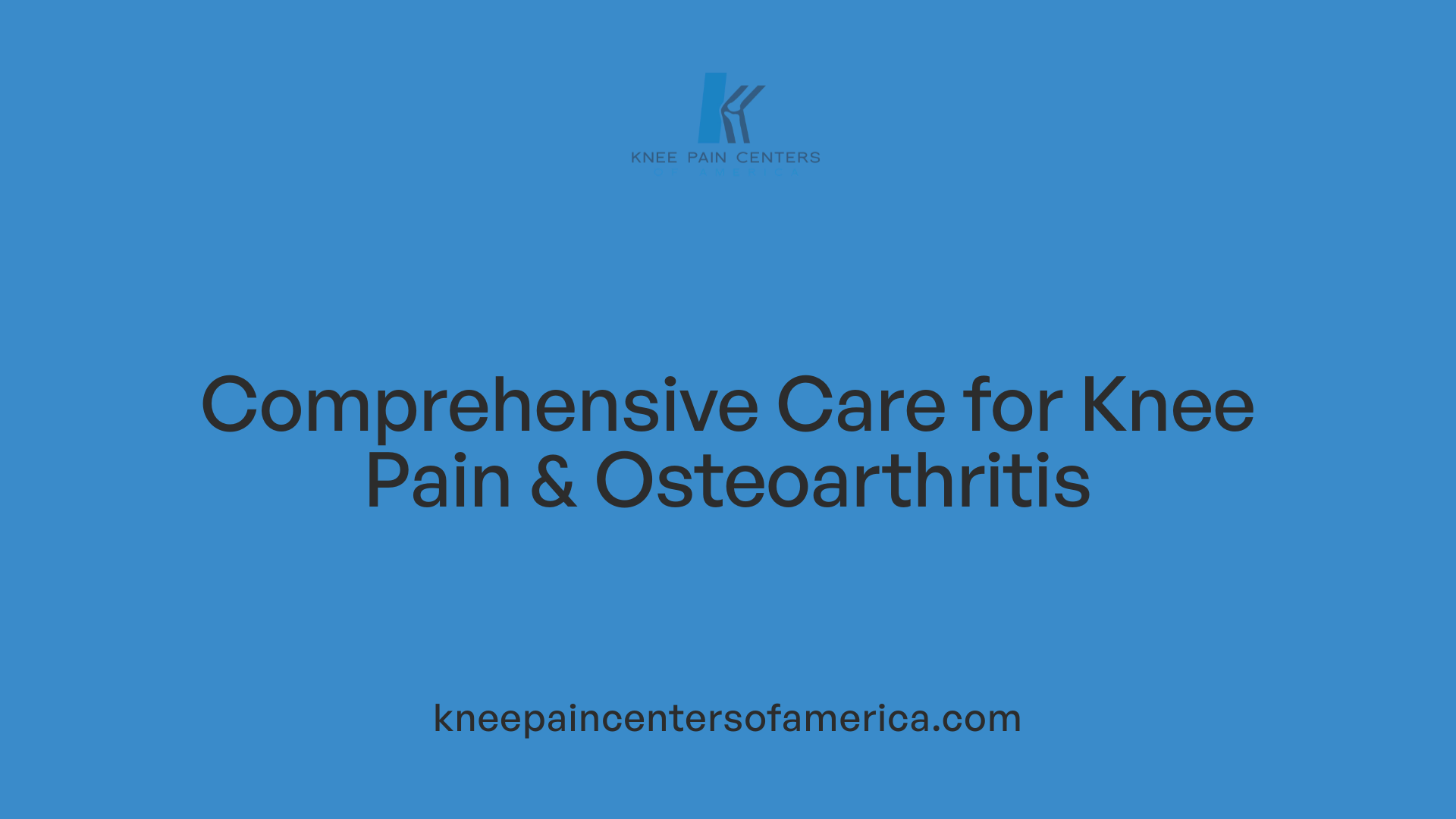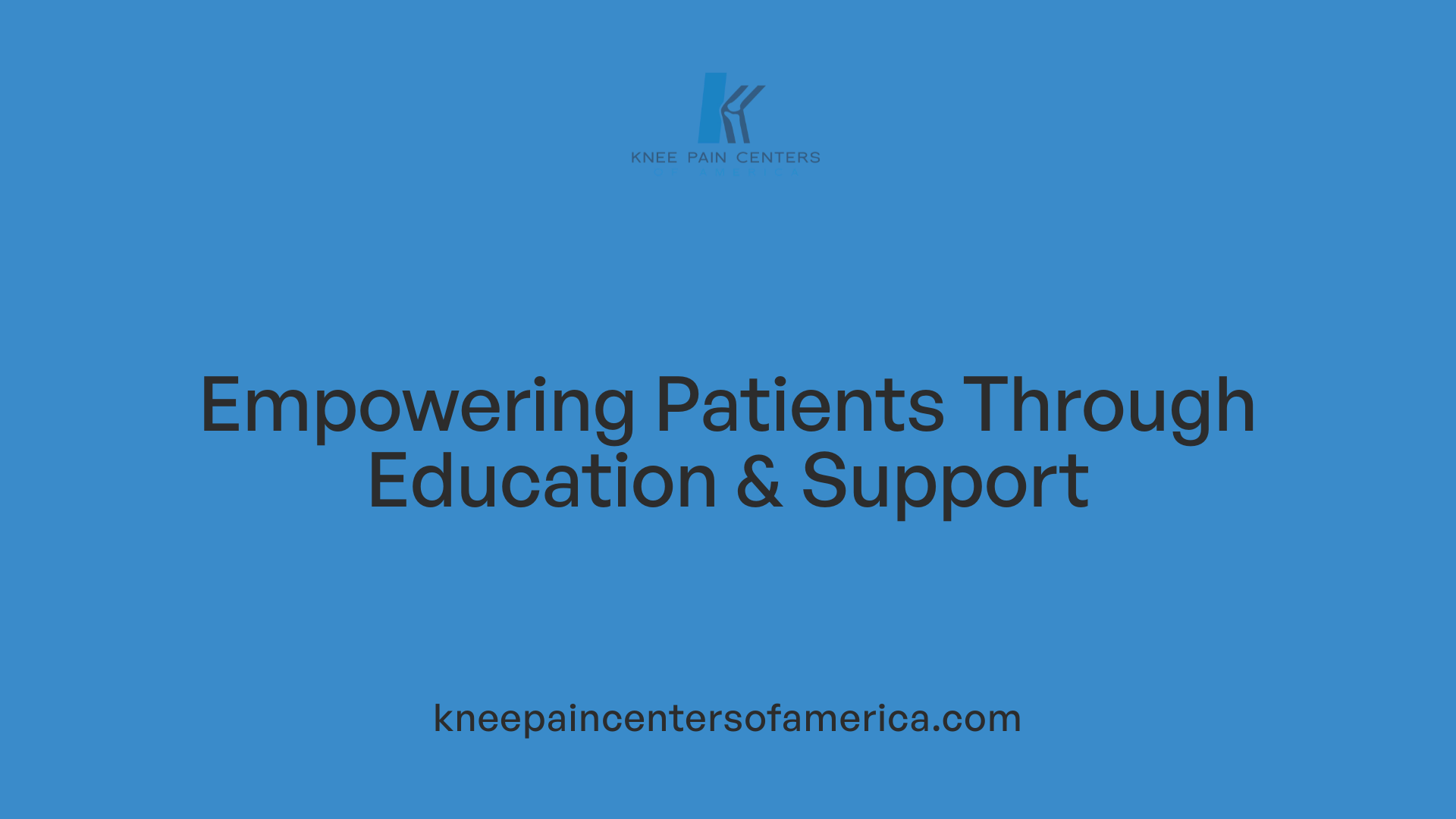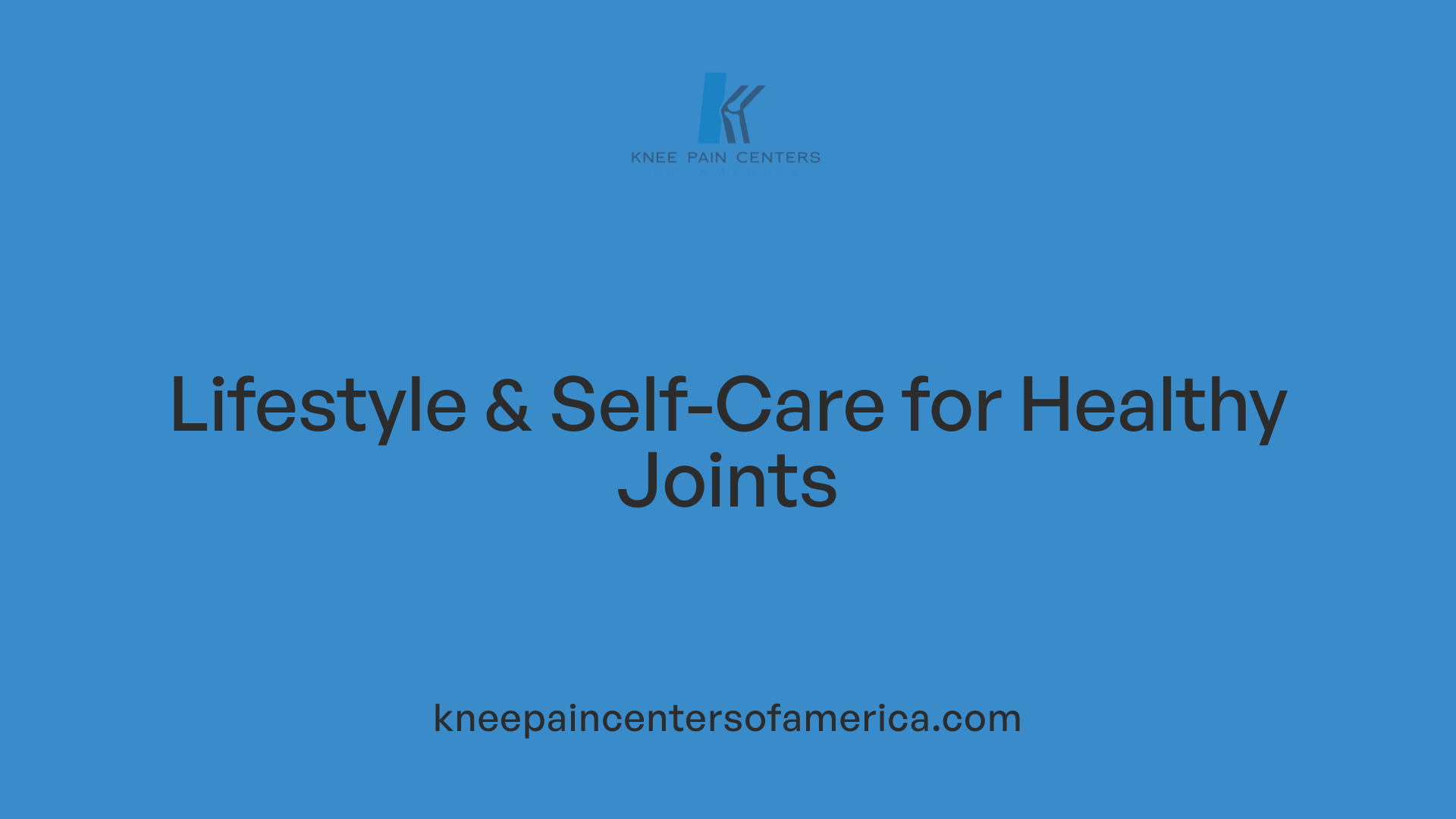Understanding the Importance of Maintenance in Knee Pain Management
Knee osteoarthritis remains a prevalent condition characterized by pain, stiffness, and reduced mobility. While immediate interventions often provide relief, the true challenge lies in sustaining these benefits over time. This article explores how regular maintenance appointments, combining medical treatments, physical therapy, and emerging therapies, play a vital role in preventing pain recurrence and preserving knee function.
Comprehensive Medical Treatments for Knee Pain and Osteoarthritis

What are the common medical treatments available for knee pain and osteoarthritis?
Knee osteoarthritis management involves a multifaceted approach, combining pharmacological, physical, surgical, and lifestyle strategies to ease pain and improve joint function.
Pharmacological Treatments
Pain relief typically starts with acetaminophen due to its safety profile. Nonsteroidal anti-inflammatory drugs (NSAIDs), including ibuprofen and naproxen, are widely used for their effectiveness against pain and inflammation but require caution due to potential side effects like gastrointestinal risks. Duloxetine and tramadol are alternatives when NSAIDs are unsuitable. Topical treatments, including capsaicin creams and NSAID gels, offer pain relief with fewer systemic effects. Intra-articular corticosteroid injections provide temporary reduction in knee inflammation, while hyaluronic acid injections aim to improve joint lubrication though results may vary.
Physical Therapy
Targeted physical therapy is crucial. Strengthening exercises, particularly for the quadriceps, increase joint stability and reduce stress on the knee. Regular low-impact aerobic exercises such as walking, cycling, and swimming enhance mobility and decrease stiffness. Supervised therapy sessions at least three times per week are linked with better pain control. Occupational therapy supports adapting daily tasks to minimize joint strain.
Assistive Devices
Braces, knee supports, shoe inserts, and walking aids help offload affected joints and promote better alignment. Using these devices can reduce discomfort and improve mobility, especially during activities that aggravate symptoms.
Surgical Options
When conservative treatments fail, surgical interventions may be necessary. Arthroscopy is rarely effective for osteoarthritis but can be used in selected cases. Osteotomy realigns the knee to relieve pressure on damaged areas. Total knee replacement (arthroplasty) offers long-term relief by replacing the damaged joint, significantly improving quality of life for severe cases.
Lifestyle Interventions
Weight management is paramount; losing 5-10% of body weight markedly reduces joint load and symptoms. Combining diet and exercise is the most effective approach. Maintaining regular physical activity tailored to patient ability helps slow disease progression and supports overall health.
Alternative Therapies
Acupuncture may provide pain relief by stimulating natural pain-blocking chemicals. Supplements like glucosamine, chondroitin, and omega-3 fatty acids show mixed evidence; consultation with healthcare professionals is advised before use. Thermal modalities, laser therapy, and TENS therapy lack strong evidence and are not routinely recommended but may be considered based on patient preference.
Overall, combining these treatments allows personalized management of knee osteoarthritis, addressing pain, function, and quality of life.
Physical Therapy and Exercise: Cornerstones of Maintenance Care

How do physical therapy and exercise help in managing knee osteoarthritis?
Physical therapy and exercise are essential components in managing knee osteoarthritis (OA). Strengthening the muscles around the knee, especially the quadriceps, plays a vital role in stabilizing the joint. This muscle reinforcement reduces stress on the damaged cartilage, helping to alleviate pain and improve joint function.
Targeted exercises improve joint flexibility and mobility, which often suffer due to OA-related stiffness. Regular physical activity also mitigates pain and stiffness, enabling individuals to maintain daily activities and enhance their quality of life.
Physical therapy customizes interventions, including manual therapy and balance training, which further support joint stability and coordination. Modification of activities to avoid excessive joint stress is also emphasized to prevent symptom worsening.
Weight management is frequently integrated into exercise plans. Reducing body weight decreases load on knee joints, slows disease progression, and enhances treatment outcomes. Combining diet and exercise yields significant benefits in symptom relief and function.
Through these comprehensive maintenance strategies, physical therapy and exercise can delay the need for surgical interventions like joint replacement. Early implementation is cost-effective and improves long-term joint health, making it a cornerstone of knee OA care.
The Role and Limitations of Injections in Sustaining Knee Pain Relief
What role do injections such as corticosteroids or hyaluronic acid play in treating knee osteoarthritis?
Corticosteroid injections are used to provide rapid, short-term relief from knee osteoarthritis pain and inflammation. They work by directly reducing inflammatory processes within the joint, which helps alleviate soreness and swelling. However, repeated corticosteroid injections may contribute to cartilage damage and potentially speed up joint deterioration.
Hyaluronic acid injections have a different approach. They aim to restore the natural lubrication of the knee joint by supplementing the viscous fluid, which helps reduce friction and improve joint movement. This can lead to longer-term symptom relief for some patients. Despite this, the benefits of hyaluronic acid vary widely, with some clinical guidelines suggesting limited routine use due to inconsistent efficacy.
How do corticosteroid and hyaluronic acid injections work?
- Corticosteroids: Suppress inflammation by inhibiting inflammatory chemicals within the joint space.
- Hyaluronic acid: Mimic and replenish natural joint fluid to improve cushioning and smooth motion.
What is the typical duration of effect for these injections?
- Corticosteroid injections: Provide symptom relief lasting from a few weeks up to a few months.
- Hyaluronic acid injections: May offer longer-lasting relief, sometimes extending up to six months in select patients.
What concerns exist regarding cartilage health with these treatments?
While corticosteroid injections control inflammation rapidly, concerns exist about potential acceleration of cartilage loss and disease progression with their repeated use. Hyaluronic acid injections are generally considered safer for cartilage, with some evidence suggesting they may help preserve joint structure, but their efficacy is still debated.
Are there emerging regenerative therapies?
New treatments like platelet-rich plasma (PRP) and mesenchymal stem cells (MSCs) injections are being investigated for their ability to repair and regenerate joint tissue, potentially altering osteoarthritis progression. However, current research is inconclusive, and these therapies are not yet standard practice.
Overall, while injections play an important role in managing knee osteoarthritis symptoms, their limitations underscore the need to combine them with other treatments such as physical therapy, exercise, weight management, and possibly surgical options for optimal long-term outcomes.
When Surgery Becomes Necessary: Indications and Options

Criteria for Surgery
Surgery for knee osteoarthritis is typically reserved for patients who have not found relief through conservative treatments like physical therapy, medications, weight loss, and injections. It is considered when pain is persistent and severe, joint function is significantly impaired, or there is instability affecting quality of life. Advanced structural damage visible through imaging, coupled with unmanageable symptoms, often guides the decision for surgical intervention.
Total Knee Replacement
Total knee replacement (arthroplasty) is the most common and definitive surgical option for end-stage knee osteoarthritis. This procedure replaces damaged cartilage and bone with prosthetic components, leading to substantial pain relief and improved mobility. It is especially effective for patients with widespread joint degeneration and has high success rates in restoring joint function.
Osteotomy
Osteotomy is a joint-preserving surgery often recommended for younger, active patients with localized knee arthritis and angular deformities. It involves cutting and reshaping bones to redistribute weight away from the damaged portion of the knee, thereby delaying the need for joint replacement. Osteotomy can improve alignment and reduce symptoms but requires careful patient selection.
Arthroscopic Procedures
Arthroscopic interventions such as joint lavage or debridement have limited roles in osteoarthritis management. They are mostly reserved for cases with mechanical symptoms like loose bodies or meniscal tears but are generally not recommended solely for osteoarthritis due to low efficacy in symptom relief.
Patient Factors
The choice and timing of surgery depend on several patient factors including age, severity of arthritis, activity level, overall health, and the presence of comorbidities. A personalized approach ensures that surgical benefits outweigh risks, optimizing recovery and outcomes.
Surgical Outcomes
Surgical interventions, especially total knee replacement, typically result in significant pain reduction and improved function. However, outcomes depend on patient adherence to rehabilitation, general health, and surgical expertise. While complications can occur, advances in surgical techniques and postoperative care have improved safety and success rates.
Emerging and Experimental Therapies: The Future of Maintenance Care
Are there any emerging or experimental treatments for knee osteoarthritis?
Emerging treatments for knee osteoarthritis are expanding beyond traditional medications and surgery, offering new hope for symptom relief and potentially slowing disease progression.
One promising minimally invasive procedure is genicular artery embolization (GAE). This technique targets abnormal blood vessels in the knee to reduce inflammation and pain. Many patients report lasting relief, which can delay or even prevent the need for knee replacement surgery.
Knee embolization follows a similar principle by selectively blocking blood flow to inflamed synovial tissue. Clinical studies show a substantial number of patients experience significant pain reduction after the procedure.
In the field of regenerative medicine, platelet-rich plasma (PRP) injections are gaining attention. PRP uses concentrated growth factors derived from the patient's blood to stimulate healing of damaged cartilage. Stem cell therapy also aims to regenerate cartilage tissue, although more rigorous research is required to confirm long-term benefits.
Genetic research has identified various markers linked to osteoarthritis development and progression. This knowledge paves the way for targeted medications and personalized treatment plans tailored to individual genetic profiles.
Collectively, these novel therapies represent an exciting frontier in knee osteoarthritis care, especially for patients who seek alternatives to conventional treatments or face limitations with surgery.
The Power of Patient Education and Support in Long-Term Pain Management

How does patient education benefit those with knee osteoarthritis?
Patient education equips individuals with a deeper understanding of osteoarthritis, helping correct misconceptions about the disease. This knowledge fosters better self-management, empowering patients to actively participate in their care. Educated patients are more likely to adhere to prescribed treatments and lifestyle modifications, leading to improved disease outcomes.
What self-management strategies support pain control and mobility?
Effective self-management includes engaging in regular low-impact exercises like cycling, walking, and swimming, maintaining a healthy weight through balanced diet and physical activity, and using supportive devices such as braces or shoe inserts. Applying heat or cold packs and topical creams with ingredients like capsaicin also provides symptomatic relief, while movement therapies such as tai chi and yoga help improve flexibility and joint function.
How does medication adherence influence treatment success?
Consistent and correct use of medications—including acetaminophen, NSAIDs, and topical analgesics—is crucial in managing pain and inflammation. Proper adherence ensures symptom control and may prevent flare-ups. Patient education enhances understanding of medication roles and potential side effects, supporting safe and effective use.
Why is psychological support important in managing osteoarthritis?
Chronic pain can lead to emotional challenges such as anxiety or depression. Psychological support, including counseling or support groups, offers coping mechanisms to manage stress and maintain mental well-being. This holistic approach helps sustain motivation for ongoing treatment and lifestyle efforts.
What coping mechanisms assist with daily challenges?
Developing effective coping strategies, like pacing activities, prioritizing rest, and seeking social support, can reduce the burden of persistent pain. Learning relaxation techniques and stress management promotes resilience and enhances overall quality of life.
How does education and support enhance overall treatment outcomes?
By combining education, self-management, medication adherence, and psychological support, patients experience greater relief from symptoms and improved physical function. This integrated approach reduces the risk of disability and may delay progression of osteoarthritis, contributing to sustained independence and well-being.
| Aspect |
Benefits |
Practical Suggestions |
| Patient Education |
Improved knowledge and treatment adherence |
Attending workshops, reading materials |
| Self-Management |
Better symptom control and mobility |
Regular exercise, weight management, assistive devices |
| Medication Adherence |
Effective pain and inflammation control |
Understanding medication use, monitoring side effects |
| Psychological Support |
Enhanced emotional well-being |
Counseling, support groups |
| Coping Mechanisms |
Stress reduction and daily function maintenance |
Activity pacing, relaxation techniques |
| Enhanced Outcomes |
Reduced pain, improved quality of life, slower disease progression |
Ongoing multidisciplinary care and patient engagement |
Lifestyle and Self-Care Strategies to Maintain Joint Health

How Important Is Weight Management for Knee Osteoarthritis?
Maintaining a healthy weight is crucial for reducing pressure on weight-bearing joints affected by osteoarthritis. Losing approximately 5-10% of body weight can significantly decrease pain and improve joint function. The most effective approach combines a balanced diet with regular physical activity to maximize symptom relief and enhance overall joint health.
What Are the Benefits of Low-Impact Exercise?
Engaging in low-impact activities, such as walking, cycling, swimming, or yoga, helps strengthen the muscles surrounding the knee, supports joint stability, and reduces stiffness. Exercise therapy, including at least 150 minutes per week of moderate aerobic exercise or twice-weekly muscle-strengthening sessions, has proven efficacy in easing pain and improving function. Avoiding high-impact exercises like running is advisable to prevent aggravating joint damage.
Which Dietary Recommendations Support Joint Health?
Adopting a diet rich in vegetables, fruits, fish, and healthy fats contributes to overall health and assists in weight management. This nutritional approach supports inflammation reduction and joint preservation. While supplements like glucosamine, chondroitin, and omega-3 fatty acids have been used by some, evidence is mixed, so consulting a healthcare provider before starting these is recommended.
How Can Assistive Devices Help Manage Symptoms?
Using braces, shoe inserts, walking aids, or splints can provide additional joint support, reduce pain, and improve mobility. Personalized fitting and guidance from physical or occupational therapists ensure that these devices effectively minimize joint stress during daily activities.
Are Complementary Therapies Useful for Managing Osteoarthritis?
Complementary treatments—such as acupuncture, balneotherapy (warm water exercises), and TENS therapy—may offer some patients relief from symptoms, but scientific evidence varies. These options should be considered alongside conventional treatments and discussed with healthcare professionals to tailor management plans.
Why Is Avoiding High-Impact Activities Recommended?
High-impact activities can accelerate joint degeneration and increase pain levels in individuals with osteoarthritis. Therefore, avoiding activities that place excessive stress on the knees helps preserve joint integrity and prolongs functional ability.
| Strategy |
Description |
Benefits |
| Weight Management |
Balanced diet and exercise aimed at reducing body weight |
Decreases joint pressure, reduces symptoms |
| Low-Impact Exercise |
Activities like swimming, walking, and cycling |
Enhances muscle strength, improves mobility |
| Dietary Recommendations |
Nutrient-rich foods supporting overall health |
Supports weight control, reduces inflammation |
| Assistive Devices |
Braces, splints, canes, shoe inserts |
Provides joint support, alleviates pain |
| Complementary Therapies |
Acupuncture, balneotherapy, TENS |
Potential pain relief but variable supporting evidence |
| Avoidance of High-Impact |
Steering clear of running or heavy-impact sports |
Prevents worsening of joint damage |
Maintaining Gains: The Importance of Regular Care in Knee Osteoarthritis
Effective management of knee osteoarthritis hinges on more than just initial treatment; it requires consistent maintenance through multidisciplinary approaches. Regular medical appointments allow tailored adjustments to therapy, ensuring pain relief and mobility are preserved over time. Combining physical therapy, appropriate use of medications and injections, patient education, lifestyle modifications, and emerging therapies forms a comprehensive strategy to keep pain from returning and improve quality of life. Ultimately, a proactive, sustained care model empowers patients to remain active and engaged, minimizing disability and postponing or avoiding surgery when possible.
References